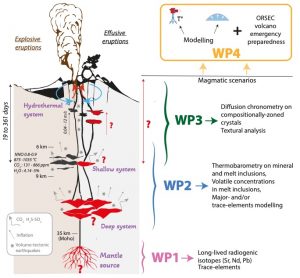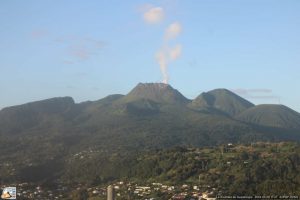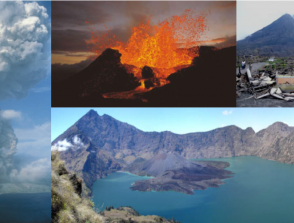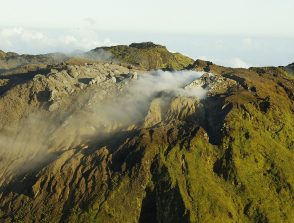UNREST: Understanding real-time moNitoRing data in terms of pre-Eruptive magmatic processes to better constrain eruption forecaSTs
Start: 01/04/2025 - End: 01/04/2029
National partnership
Coordinators : Carole Berthod
Host institutions :
IPGP, IPGP
Partner institutions :
OVSG-IPGP, IPGP, LMV-UCA, Université Paris Saclay, BRGM, SEDISOR
Related observatories :
Volcanological and Seismological Observatory of Guadeloupe (OVSG-IPGP)
Related teams :
Volcanic Systems
Project funded by the French Agence Nationale de la Recherche (ANR), under grant “ANR- 21-CE49-5386 (project UNREST)”
Much effort has been made to forecast eruptive activity on volcanoes using approaches such as seismic and geodetic monitoring, or changes in gas composition. However, there is a growing need to understand and quantify what these monitoring signals mean in terms of magmatic processes at depth and their dynamic evolution towards destabilization. In addition, on many volcanoes there is no good instrumental record of past eruptions, and thus the need to determine and quantify the causal links between deep magmatic processes and surface activity is even more acute. This challenge is at the heart of the UNREST project, oriented towards the contributions of petrology and geochemistry for the anticipation and monitoring of unrest crises of volcanic systems. With this objective, we will reconstruct the magmatic system beneath La Soufrière of Guadeloupe and its evolution over time, based on the compositions and physical properties of the solid volcanic products. We will determine and characterize magmatic processes that lead to magma reservoir failure, magma ascent and their timescales. These results will then be modeled in terms of the geophysical signals recorded by monitoring networks and will be applied to La Soufrière of Guadeloupe. Finally, UNREST findings will be shared with other observatories in the Lesser Antilles Arc.
The UNREST project is divided into 4 work packages (Figure 1) that will enable us to characterize the magmatic system that fed the Soufrière de Guadeloupe eruptions from source to surface, and link the identified processes with the surface signals recorded by the monitoring network of the Observatoire Volcanologique et Sismologique de Guadeloupe (OVSG, IPGP).
The project involves 15 researchers from 6 institutes (OVSG-IPGP, IPGP, LMV-UCA, Université Paris Saclay, BRGM, and SEDISOR) and will include 2 PhD students and a postdoctoral fellow.

Figure 1: Contents of the UNREST work-packages (WPs).
WP1: How deep mantle processes control the recharge and evolution of magma reservoirs and volcanic activity?
Magma production in the mantle and deep transfer processes are increasingly thought to control the recharge and evolution of magma reservoirs, and ultimately volcanic activity (Vlastelic et al., 2023). Unfortunately, the crustal history of magma blurs the signatures of deep processes, in particular in arc setting. To better understand how deep mantle processes control the activity of La Soufrière, we will call upon long-lived radiogenic isotopes (Sr, Nd, Pb) that allow a view beyond the crustal processes. High-precision isotopic compositions will be measured in a suite of juvenile fragments from La Soufrière eruptions, and Basse Terre volcanism, to (1) characterize the fine structure of the mantle source, (2) understand how mantle components are sampled during the growth history of La Soufrière, and identify the link with eruptive activity at the surface, and (3) resolve potential temporal trends indicative of source depletion or refertilization.
WP2: What are the architecture and the dynamics of the magmatic system of La Soufrière?
Pre-eruptive conditions and evolution of the magmatic system feeding La Soufrière effusive and explosive eruptions will be reconstructed using petrological (thermobarometry, volatile concentrations in melt inclusions) and geochemical (major- and trace-elements modeling) methods on juvenile fragments. Our main goals are to precisely locate the different magma storage levels whose reactivation could be identifiable by seismology and constrain the pre-eruptive parameters that may exert a strong influence on eruptive style (volatile content, crystallinity, etc). Our study will then identify processes that may have led to magma reservoirs failure, efficient magma ascent to the surface and eruption. In addition, plutonic xenoliths, brought to the surface during eruptions and representing portions of crystal mush or cumulate residues, will be used to determine the nature of post- and syn-magmatic crustal processes undetectable with erupted rocks.
WP3: What are the kinetics of this magmatic system?
WP3 will focus on temporal activation of the shallow magmatic system before and during eruptive episodes. In that way, diffusion chronometry will be applied to compositionally-zoned crystals to provide timescales between magma injection and eruptions and will be compared to the five eruptions already studied (Metcalfe et al., 2022 and references therein). In addition, textural features will be used to distinguish shallow, late-stage magma ascent processes occurring on syn-eruptive timescales and their control on eruptive mechanisms and styles. Macro textures of juvenile fragments will inform about density, porosity and permeability of the erupted rocks, while percentage, morphology, size, and size distributions of vesicles and crystals will quantify their nucleation and growth history and will be used to quantify decompression rates and ascent velocities.
WP4: What monitoring signals should be expected for each magmatic/eruptive scenario?
In WP4, we will systematically investigate the correlation between pre-eruptive and eruptive processes of each magmatic scenario and their associated potential monitoring signals. For example, using petrological study coupled with fractional crystallization models, we will estimate (1) the amount of intruded magma before each eruption, and (2) the fractional latent heat released. These results will then be discussed (i) in terms of the deformations that can be recorded for the Soufrière geodesic network, and (ii) in terms of thermal output at the surface. Finally, our different magmatic scenarios, their phenomena and associated modeled monitoring signals will be compared to La Soufriere 2020-2021 eruption on St Vincent and the eruption of Soufrière Hills on Montserrat (1995-ongoing).
Finally, the findings arising from the UNREST project will be integrated into the La Soufrière volcano Emergency Preparedness Plan (Plan Orsec in French), defined by civil protection authorities, to refine plausible magmatic eruptive scenarios.
Metcalfe 2022 A Insights into the origin and dynamics of past eruptions of La Soufrière de Guadeloupe from melt inclusions: implications for future unrest and environmental impact. Thèse, IPGP.
Vlastélic et al., (2023). Arc volcano activity driven by small-scale metasomatism of the magma source. Nat. Geosci. 16, 363–370 https://doi.org/10.1038/s41561-023-01143-0

Picture of La Soufrière de Guadeloupe, 29-03-2024, IPGP-OVSG






